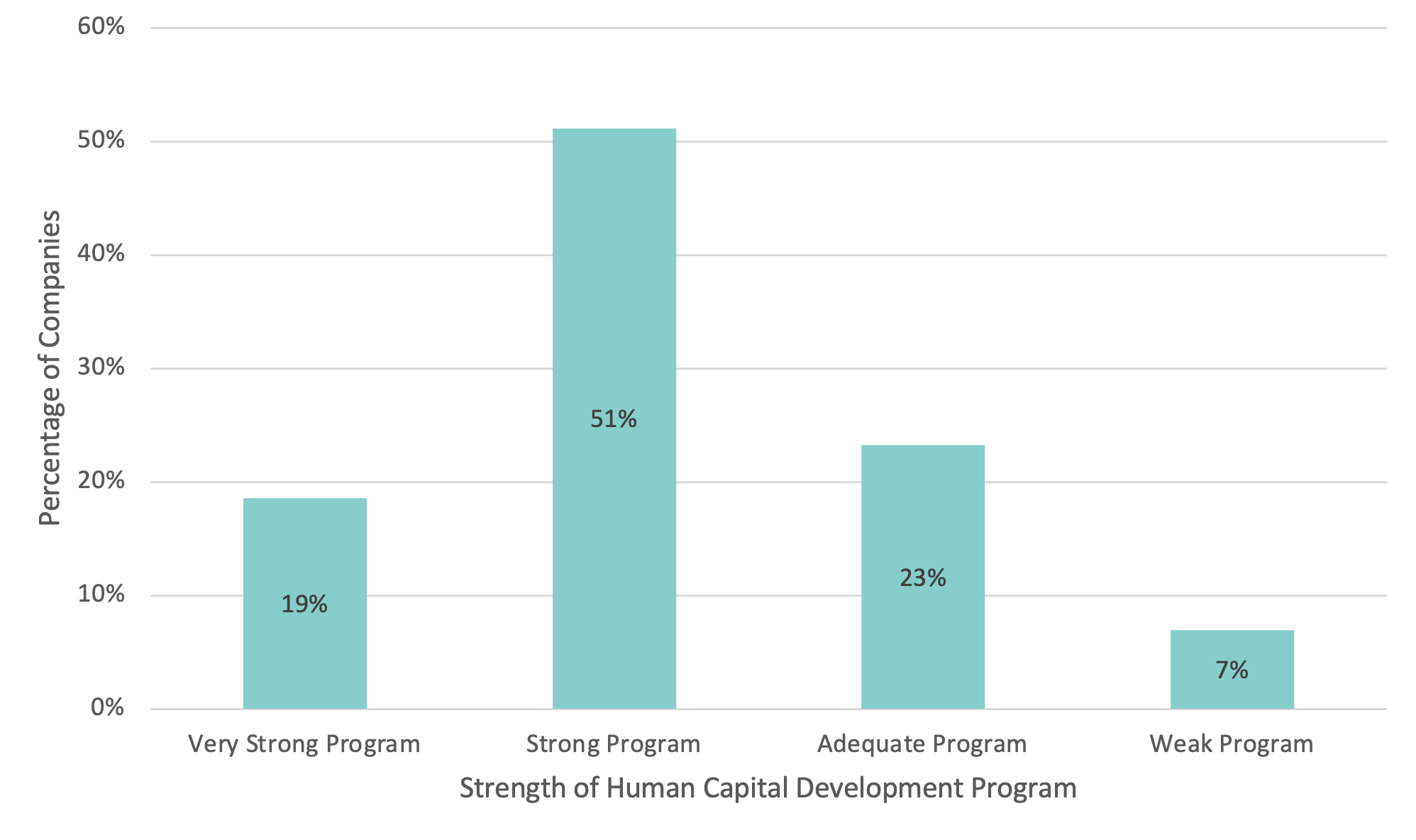The European Union and the United Kingdom want to stop the sale of new diesel and gasoline cars and vans by 2035. In the U.S., California has also proposed rules that would end the sale of new fossil-fuel vehicles by 2035 and other states have followed suit. While such regulations may be a positive step towards a net-zero economy, they also present human capital risks to the automotive industry. Adding further pressure is demand from a consumer base that increasingly expects advanced connectivity and smart features in their vehicles.
A rapid shift to scale the production of electric, connected vehicles demands significant changes to both the size and skillset of the auto industry’s workforce. This brings challenges for car manufacturers, particularly for legacy automakers with traditional operating models focused on producing internal combustion engine (ICE) vehicles. In this article, we’ll be looking at how these challenges are impacting the automotive industry and how they are managing their human capital risks.
Skills Race: Navigating Intense Competition for Key Technology Advancements
In 2022, over 50% of vehicles sold worldwide were connected cars1 and by 2030, this percentage is expected to grow up to 95%.2 Additionally, by 2030, 12% of connected cars sold are expected to have level three (i.e., limited driver intervention under specific conditions) or four (i.e., no driver intervention under specific conditions) autonomous driving functionalities.3 As consumers demand more intuitive cars that can offer driver assistance and personalized functionality, automakers need to invest in developing a workforce with the skills to deliver this advanced connectivity – a workforce with dedicated technology skills to design and manufacture next-generation vehicles.
As such, skills in the areas of AI, data analytics, software development and cybersecurity are becoming critical for automakers to innovate and maintain competitiveness. Failure to secure such talent can lead to delays in the launch of new vehicles, or even quality issues with existing models.
Legacy carmakers are now heavily recruiting from the software talent pool. Honda, for instance, plans to double its number of software engineers to 10,000 by 2030.4 Meanwhile, Toyota is investing in retraining programs and aims to have 18,000 software engineers by 2025.5 Automakers today not only have to compete among each other for top talent. They also face competition from the IT sector and auto suppliers. This competition for top tech talent puts even more pressure on legacy automakers to catch-up, while also bringing financial challenges to an industry already heavily invested in the transition to electric vehicles (EVs).
Sparks in the Industry: Labor Unrest in the Transition to Electric Vehicles
With over ten million EVs sold in 2022,6 and 16.7 million expected to be sold in 2024,7 the EV market is growing at a very fast pace. Automakers have set ambitious targets to scale up their EV production in response to both customer demand and regulations pressuring the industry to cut CO2 emissions. Some manufacturers are even planning to produce only EVs in some of their core markets.8
Such plans come with high costs for companies. According to the International Energy Agency, major automakers are planning to spend around 50-70% of their capital expenditure and R&D budgets on EVs and digital technologies.9 They are also restructuring operations and slowing or stopping investments in ICE vehicles, which could lead to plant shutdowns and related layoffs. Concerns over these cost-saving approaches to invest in EV product development can lead to labor strikes.
In September 2023, for example, the industry saw an unprecedented six-week strike involving almost 50,000 United Automobile Workers’ (UAW) members from Ford, General Motors and Sellantis.10 Among its demands, the UAW included job security requirements that would help protect its members during the industry’s transition to EV production, such as the right to strike over plant closures and compensation if a factory is closed.11 The strike has had operational and financial repercussions for the companies involved, which reported combined lost profits of US$3.6 billion12 and 175,000 fewer units produced by Ford13 and GM.14
The tentative agreements reached with the UAW will increase costs for these automakers, who have already started to reconsider their EV related budgets. Ford has already announced a delay in its US$12 million investment in EV production.15 GM also announced it will scale back its EV production plans, even cancelling a US$5 billion joint program with Honda to develop more affordable EVs.16 With the UAW aiming to unionize another 13 automakers in the U.S.17 – including Volkswagen, Toyota, Mercedes-Benz, BMW and Tesla – risks of further labor unrest could increase. One signal investors may look at to evaluate such risks is how many employees in a given company are covered by collective bargaining agreements (CBAs). Broader coverage can be an indicator of stronger labor relations and dialogue.
According to Morningstar Sustainalytics data, only 26% of the automakers we evaluate have the majority (greater than 50%) of their employees covered by collective bargaining agreements. Most companies either have either limited (44%) or no (30%) CBAs (see Figure 1).18
Figure 1. Total Automakers’ Workforce Covered by Collective Bargaining Agreements

Source: Morningstar Sustainalytics. For informational purposes only.
Driving Change: Automakers and Human Capital Risk Management
With the changing automotive industry, manufacturers will have to make significant investments in hiring the skilled talent they need. Developing and retaining talent must become a priority. This is particularly important for legacy automakers that need to go through major restructuring as they pivot their business models to focus on software and EV production. Sustainalytics data highlights that auto companies in our ratings universe have a wide range in the quality of their human capital programs (see Figure 2). Human capital development programs include such factors as detailed reporting on risks relating to human capital management, recruiting initiatives, and efforts to retain and develop the labor force to manage related risks.
Figure 2. Strength of Human Capital Development Programs Across Auto Companies
 Source: Morningstar Sustainalytics. For informational purposes only.
Source: Morningstar Sustainalytics. For informational purposes only. Notably, 19% of auto companies in our ratings universe have a very strong human capital development program and 51% have a strong program, signaling that automakers are taking the issue seriously. However, 30% of companies have an adequate or weak human capital development program, signaling room for further improvement for some players in the industry to mitigate related risks.
Some companies have started targeting recruitment for specialized talent, resorting to acquiring tech companies or setting up venture teams to invest in or acquire EV-related start-ups to secure talent.19 Major automakers such as Mercedes-Benz or Ford are also shifting financial resources towards reskilling and upskilling their workforce in areas of electrification and digitalization, including AI.20 With many automakers already investing in strong initiatives for workforce recruitment and retention, winning the race in this new competition for talent will depend on how successfully they execute their talent management strategies.
References
- Team Counterpoint. 2023. "Connected Car Sales Grew 12% YoY in 2022 With Volkswagen Group in Lead. " April 24, 2023. Counterpoint Technology Market Research. https://www.counterpointresearch.com/insights/global-connected-car-market-2022/#:~:text=Global%20connected%20car%20sales*%20grew,followed%20by%20China%20and%20Europe
- Bertoncello, M., Martens, C., Schneiderbauer, T. & Zedelius, K. 2023. "Corporate business building to unlock value in automotive connectivity." August 31, 2023. McKinsey & Company. https://www.mckinsey.com/industries/automotive-and-assembly/our-insights/corporate-business-building-to-unlock-value-in-automotive-connectivity
- Ibid.
- Bell, S. 2023. "Toyota, Honda Looking to Hire All the Software Engineers They Can to Compete With Tesla." May 30, 2023. Carscoops. https://www.carscoops.com/2023/05/toyota-honda-look-to-vastly-expand-number-of-software-engineers-to-compete-with-tesla/
- Ibid.
- International Energy Agency. 2023. Global EV Outlook 2023. https://iea.blob.core.windows.net/assets/dacf14d2-eabc-498a-8263-9f97fd5dc327/GEVO2023.pdf
- O’Donovan, A. 2024. "Electrified Transport Market Outlook 4Q 2023: Growth Ahead." January 4, 2024. BloombergNEF. https://about.bnef.com/blog/electrified-transport-market-outlook-4q-2023-growth-ahead/
- Yang, Z. 2022. "Beyond Europe: Are there Ambitious Electrification Targets across Major Markets?" November 15, 2022. International Council on Clean Transportation. https://theicct.org/global-oem-targets-cars-ldvs-nov22/
- International Energy Agency. 2023. Global EV Outlook 2023. https://iea.blob.core.windows.net/assets/dacf14d2-eabc-498a-8263-9f97fd5dc327/GEVO2023.pdf
- Shepardson, D. & White, J. 2023 "UAW reaches deal with GM, ending strike against Detroit automakers." October 31, 2023. Reuters. https://www.reuters.com/business/autos-transportation/gm-reaches-tentative-deal-with-uaw-source-says-2023-10-30/
- Long, H. 2023. "Opinion | Actually, the UAW won something even bigger than wage hikes." November 1, 2023. The Washington Post. https://www.washingtonpost.com/opinions/2023/11/01/uaw-auto-industry-strike-pay-job-security/
- Brajkovic, V. 2023. "UAW Strike Cost Big 3 Automakers $3.6B in Combined Lost Profit." December 1, 2023. Modern Distribution Management. https://www.mdm.com/news/operations/manufacturing/uaw-strike-cost-big-3-automakers-3-6b-in-combined-lost-profit/
- Walz, E. 2023. "Ford lost $1.3B due to the UAW strike, zapping its Q3 profits." October 27, 2023. AutomotiveDive. https://www.automotivedive.com/news/ford-q3-earnings-lost-13b-uaw-strike/698070/
- Boudette, E. N. & Lu, Y. 2023. "G.M. to Cut Spending on Cruise Self-Driving Unit." November 29, 2023. The New York Times. https://www.nytimes.com/2023/11/29/technology/cruise-general-motors.html
- Rosevear, J. 2023. "Ford shares fall 12% after earnings underline worries about costs and EV plans." October 27, 2023. CNBC. https://www.cnbc.com/2023/10/27/ford-f-shares-fall-q3-earnings-ev-costs-uaw.html
- Shepardson, D. 2023. "GM still planning to end gas-powered vehicle sales by 2035." December 13, 2023. Reuters. https://www.reuters.com/business/autos-transportation/gm-still-planning-end-gas-powered-vehicle-sales-by-2035-ceo-2023-12-13/
- Bushey, C. 2023. "Emboldened US union launches membership drive across 13 carmakers." November 30, 2023. Financial Times. https://www.ft.com/content/316dbc8a-9138-426c-a4a3-a464b6d5d4cd
- Data is according to Morningstar Sustainalytics Ratings universe, which comprises approximately 5,000 large and medium market cap investable issuers in developed and emerging markets.
- White, J. 2023. "Stellantis invests 100 million euros in startups, mobility fund." June 15, 2023. Reuters. https://www.reuters.com/business/autos-transportation/stellantis-invests-100-million-euros-startups-mobility-fund-2023-06-15/
- Brady, M. 2023. "Mercedes-Benz invests over $2.2B in AI reskilling." August 1, 2023. AutomotiveDive. https://www.automotivedive.com/news/mercedes-benz-investing-22b-ai-artificial-intelligence-reskilling-upskilling/689603/




